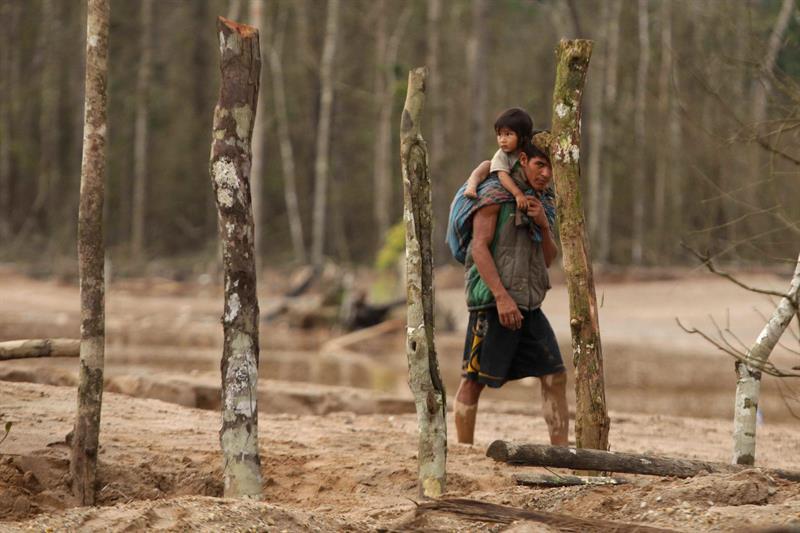RIO DE JANEIRO, BRAZIL – In the shadow of the covid-19 crisis, the Amazon is silently suffering one of its worst moments in the face of its particular pandemic: deforestation, which in 2020 alone devastated 2.3 million hectares of rainforest, an area larger even than the entire area of El Salvador.
The latest data estimated by the Monitoring of the Andean Amazon Project (MAAP), which monitors the progress of deforestation through satellite images, have revealed an increase in the virulence of deforestation coinciding with the health emergency, making 2020 the third-worst year in history.

Far from the world focus that occupied the Amazon with the fires recorded in 2019, 2020 was much more dramatic with an increase of 17% over the previous year, caused mainly by much more serious forest fires that did not have this time the attention of the international community.
This upsurge led Bolivia, Ecuador, and Peru to break their deforestation records last year, while Colombia and Brazil had their second and sixth-worst annual records ever, respectively.
LARGE FIRES IGNORED GLOBALLY
In Brazil, the country with the largest territory of the nine countries that share the Amazon basin, 1.5 million hectares were deforested, 13% more than in 2019, a year in which it was the epicenter of fires that occupied front pages of newspapers around the world.
“In 2019, there were many more news stories about fires in the Amazon, but they were in areas already deforested. They were only burning trees that had already fallen, but in 2020 there were forest fires because it was a drier year,” MAAP researcher Matt Finer explains to Efe.
It is a process that is repeated year after year, mainly in southwestern Brazil: first, between February and April, the forest is cut down, and then, between June and October, when it is the dry season, what is left is burned to expand land for cattle ranching, the most common “strain” of the Amazon deforestation virus.
However, all these human-caused fires got out of control in 2020 and caused even more destruction than the previous year, when all the world’s concern was focused on the world’s green lung.
The same situation occurred in Bolivia, which closed the year with a loss of 240,000 hectares, the highest record in its history, mainly due to large fires in the southeast of the country that affected the Chaco and Chiquitano forests.
WORRYING WARNINGS FOR 2021
The year 2021 does not invite optimism either, since last March was the month in which the most deforestation was recorded in Brazil in the last six years, with 367,600 hectares of forest, 12.6% more than in the same month last year, according to the National Institute of Space Research (INPE).
“In Brazil, everyone is obsessed with numbers, and sometimes we lose sight of the reality of the problem, but yes, we have seen through satellite images that deforestation is serious,” Finer said.
“The plots that are deforesting now will be the fires you see in August. Very few understand this link,” warned the specialist from MAAP, an initiative of the Amazon Conservation organization.
Colombia follows in 2021 the same path of 2020, which was the second-worst year in its history of Amazon deforestation by losing 140,000 hectares, 53% more than the previous year.
In contrast to Brazil, Peru, and Bolivia, where deforestation burns between June and October, in Colombia, it is between February and April, and that allows us to foresee “what is coming every year, and we have already seen that it is serious,” warns Finer.
For yet another year, deforestation in Colombia was concentrated in an arc that runs between the departments of Putumayo, Caquetá, Meta, and the Guaviare, where, for example, the Serranía de Chiribiquete National Natural Park lost more than 1,000 hectares in just the last six months, according to a recent MAAP report.
THOUSANDS OF SMALL FOREST BITES
While in Brazil, deforestation usually occurs on a large scale, with large geometric areas being razed, in Colombia, Ecuador, and Peru, forest loss is on a small scale, with small plots of one or two hectares being cut down.
It is shifting agriculture, where families burn a small area to plant crops. Still, when they burn it, the land loses fertility and is only productive for one year, so the following year, they must repeat the process in an adjacent area.
“That is why it is a complicated problem to control. There is no one company map to blame. There are thousands and thousands of cases of small-scale deforestation, probably linked to agricultural activity,” says Finer.
Peru lost 190,000 hectares in 2020, 18 % more than 2019, the worst record in its history, as did Ecuador, with 19,000 hectares of Amazon forests deforested, 68 % more than the previous year.
Other “strains” of deforestation also have a strong presence in these territories, such as drug trafficking, illegal logging, and alluvial mining, also an illegal practice that also pollutes the rivers of the Amazon, where hundreds of indigenous peoples live.
Source: efe/d/brb/rte

